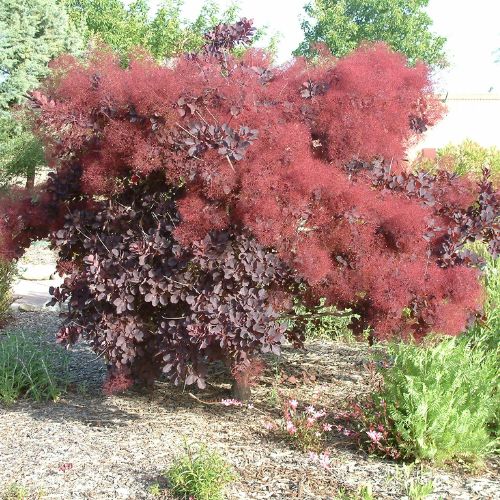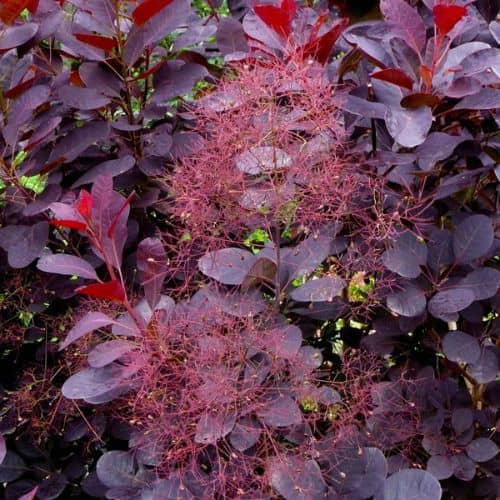The Smoketree, scientifically known as Cotinus, originates from the sun-drenched landscapes of southern Europe and Asia. The Smoketree has become well-adapted to various climates and soils. its intriguing flowering structure, making it a sought-after choice for those seeking a touch of elegance in their gardens.

Preferred Growing Conditions
When planting a Smoketree, choose a location with well-drained soil, as these trees do not tolerate waterlogged conditions. Full sunlight is ideal for optimal growth and flowering, although Smoketrees can tolerate partial shade. Adequate watering supports healthy growth, especially during dry spells and the establishment phase. Applying a layer of mulch around the tree’s base helps retain soil moisture, regulate temperature, and suppress weeds. Smoketrees are known for their drought tolerance once established, making them suitable for regions with sporadic rainfall.
Pruning is often done to shape the tree and remove dead or crowded branches. Smoketrees can be pruned to maintain a specific form, and rejuvenation pruning can be applied to encourage vigorous growth and a denser canopy. The distinctive flowering structure, which resembles plumes of smoke, is a highlight of the Smoketree, and proper pruning can enhance the overall aesthetic appeal of this unique feature.
Size, Shape, and Growth Rate
Smoketrees are generally small to medium-sized, ranging from 10 to 20 feet tall at maturity. They feature a rounded to oval crown, with branches that spread gracefully. The overall shape of Smoketrees is often described as open and airy, creating a visually pleasing silhouette. Smoketrees exhibit a moderate growth rate, striking a balance between steady development and the ability to maintain their distinctive form. The moderate growth rate contributes to the tree’s longevity and adaptability to environmental conditions. Gardeners can expect a well-proportioned and visually appealing tree that matures gracefully over the years, adding enduring charm to the landscape.
Leaves and Flowers
The leaves and flowers of the Smoketree contribute to its mystique and ornamental allure. The leaves, with serrated edges, are typically oval to obovate, and create a lush and green backdrop for the tree’s distinctive flowering structure. The foliage is arranged loosely and irregularly, contributing to the tree’s informal and naturalistic charm.
What sets the Smoketree apart is its unique inflorescence, which consists of clusters of tiny, inconspicuous flowers surrounded by long, feathery filaments. These filaments often likened to plumes of smoke or clouds, create a captivating effect that gives the tree its name. The flowers appear in late spring to early summer and can vary among different cultivars, ranging from soft pink and lavender to deeper shades of purple. The delicate and feathery appearance of the flowers adds a touch of drama to the garden, making the Smoketree a standout feature in any landscape.

Uses in Gardening and Landscaping
The captivating flowers of Smoketrees make them excellent focal points in gardens, where they can be planted as specimens or in groupings. They can be strategically placed to create visual interest, frame views, or provide a stunning backdrop for other plants. Their moderate size and adaptability suit residential gardens and larger landscapes.
These trees are particularly valued for their role in adding drama and a sense of whimsy to garden designs. Their unique flowering structure is a conversation starter, and the wispy plumes create a dreamlike atmosphere. Smoketrees can be integrated into mixed plantings, complementing other shrubs, perennials, or ornamental grasses. Their informal shape and texture make them versatile companions in various garden styles, from cottage gardens to modern landscapes.
In addition to their aesthetic contributions, Smoketrees are low-maintenance and generally resistant to pests and diseases. This makes them attractive choices for gardeners seeking visually striking plants that are easy to care for. Smoketrees can also be grown in containers, allowing for flexibility in placement on patios, decks, or balconies.
